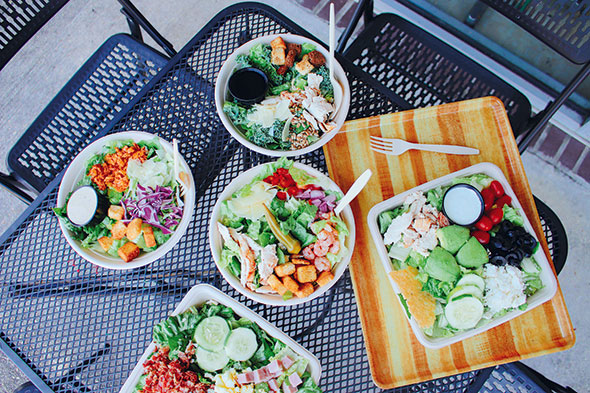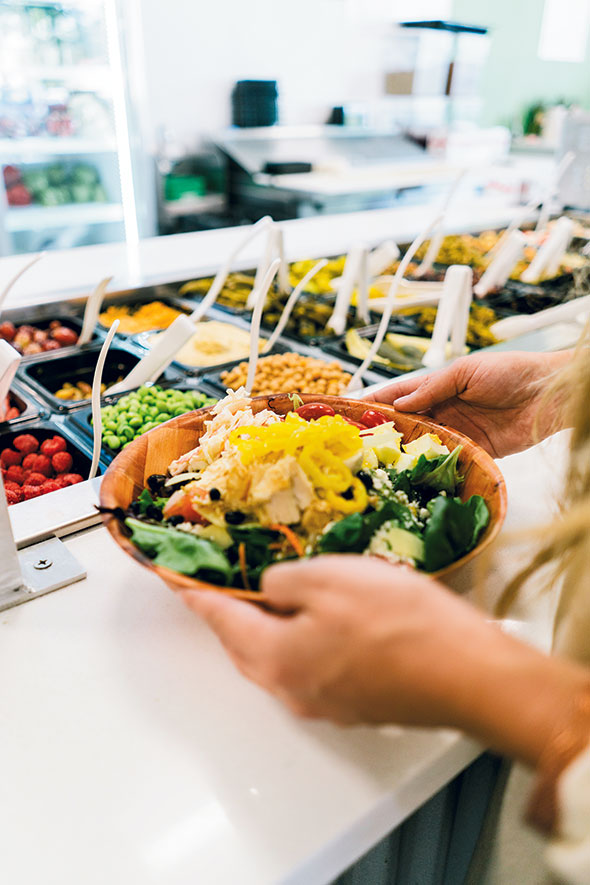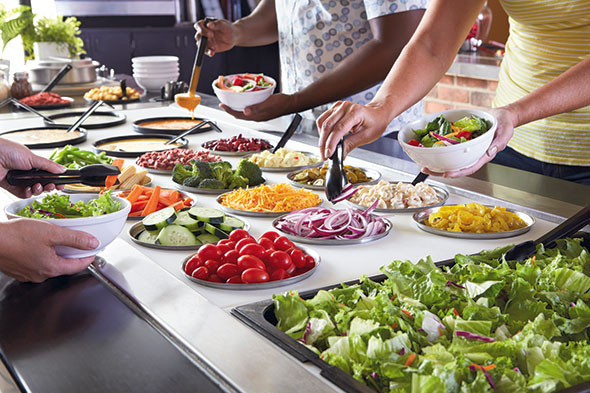With health and food safety on the forefront of consumers’ minds today, salad would seem a safe and smart bet. Yet, when it is available in a self-serve format, diners may now take pause.
When looking to the future and a post-COVID-19 environment, The Salad Station’s protocol may be one to emulate, as the chain takes sanitation to a whole new level. Even before the pandemic, prior to visiting the food bar, the chain required customers to first visit the sanitation station for hand sanitizer and disposable vinyl gloves, a mandatory requirement.
 Photo courtesy of The Salad Sation
Photo courtesy of The Salad Sation
“We took these initiatives before [the pandemic], and it made people feel safe,” says Scott Henderson, president of the Hammond, La.-based concept, which has 24 locations, 8 more under construction and others in the pipeline. “We didn’t want the perception of our restaurants to be the stereotypical buffet; we’re a gourmet concept with the focus on sanitation.”
According to Chicago-based Datassential’s MenuTrends report, self-serve salad bars have declined a bit in the past four years but appear on 3.1% of menus. Pre-pandemic, the format remained popular among buffet or cafeteria-style midscale restaurants, such as Sizzler and Cici’s Pizza.
Food halls, which often service a workplace crowd, were another outlet for salad bars pre-pandemic. Foodservice management company Compass North America, based in Charlotte, N.C., for example, operates the Forum 55 food hall in Chicago, with a focus on ingredients from local purveyors in its expansive Community Garden salad bar. While the facility was temporarily closed at press time due to the pandemic, when it’s back up and running, the goal is for customers to again enjoy its typical list of rotating items, which include charcuterie, smoked salmon and trout, and grain salads.
In terms of overall salad ingredient trends, Datassential has noticed more global influences with add-ins like pomegranate (up 49% on salad menus over the past four years), falafel and seaweed. Nutrient-rich ingredients also are on the rise, including sunflower seeds, farro, quinoa and edamame.
Ahead of Its Time
 The Salad Station’s salad bars offer more than 100 toppings, which the chain describes as both traditional and gourmet options.The Salad Station continues to offer pickup and delivery during the pandemic. Scott Henderson founded the chain in 2012 with the support of his mother and business partner, Cindy Henderson. The restaurants’ self-serve, pay-by-the-pound approach not only reduces waste, but it also supports franchisees with a low-cost labor model.
The Salad Station’s salad bars offer more than 100 toppings, which the chain describes as both traditional and gourmet options.The Salad Station continues to offer pickup and delivery during the pandemic. Scott Henderson founded the chain in 2012 with the support of his mother and business partner, Cindy Henderson. The restaurants’ self-serve, pay-by-the-pound approach not only reduces waste, but it also supports franchisees with a low-cost labor model.
“The salad bar segment was really trending up the last few years, and ours is very unique with an overwhelming selection,” says Scott. “As we realized the demand, need and desire, we started opening more franchised restaurants; we don’t expect it to slow down.”
Here’s how things looked before shelter-at-home orders: Customers selected from more than 100 toppings and hot bar offerings, including nontraditional food bar items, like sushi. Offerings rotate, unlike traditional salad bars, and include a wrap option. In addition, The Salad Station offers hot vegetables, proteins and multiple beverage bubblers. Staff members prep ingredients from 8 a.m. to 10 a.m.
A year after opening, The Salad Station’s new sites became more transparent in terms of production. “Prior to 2013, our salad bars were against the wall and kitchens were in the back,” says Scott. “We realized with everything we’re doing — being fresh and as a brand of integrity — we wanted people to know what’s happening in the kitchen.”
The change opened things up and enabled guests to see the kitchen space behind the salad bars in the center of the dining room. Customers could watch staff prep produce and hot bar items. This layout also holds The Salad Station accountable to its high food safety standards.
The chain had also recently stepped up its food safety and sanitation efforts prior to the pandemic. Instead of just depending on signs instructing customers to don disposable gloves before self-serving, the chain had a dedicated staff member hand them out. Henderson was working on having images printed on The Salad Station’s gloves to drive home its message of being both fresh and safe. He wants gloves to be associated with the brand.
In addition, The Salad Station staff constantly changed serving utensils on-site — and still does. Black-handled utensils were used for serving starting at 10 a.m. and changed out for white-handled utensils at 2 p.m. More recently, the chain started changing the utensils hourly. “We were already taking the extra safety steps that restaurants began implementing during the COVID-19 pandemic,” says Scott. “It was all about being the cleanest restaurant we could be.”
The focus on hygiene extended to the dining room and all touch points throughout the operation. Even before the pandemic shut down on-site dining, a full-time staff member was continuously cleaning and sanitizing tables, chairs, highchairs, credit card terminals, railings, POS systems and the self-serve beverage area. “We’ve always had a staff member overseeing our initiatives and strictly focusing on the sanitation of our restaurants,” says Scott.
When the coronavirus hit, The Salad Station’s concept quickly adapted and changed its business model to online ordering with chef-driven takeout salads. Customers can choose up to 10 toppings. “When we reopen our dining rooms, we will continue offering these recipes and online ordering,” says Scott. “Online ordering was something we’ve wanted to institute, and the virus made us quickly act on that.”
The chain’s online orders grew 700% in just a couple of weeks after shuttering its dining rooms due to COVID-19. “Not every customer wants to think on their own, and we don’t want to overwhelm people, so what comes out of this is we’ll capture both audiences — those who want to create their own salad at the bar and customers who want one created for them,” says Scott.
Caught in the Crossfire
The Salad Station notwithstanding, much of the traditional salad bar segment’s decline can be attributed to the struggling buffet business. While chains with salad bars like Ponderosa and Bonanza flourished in the ’70s and ’80s due to their popularity with older consumers, the proliferation of fast-casual dining and its healthier options at the same price point have impacted these operators.
“Sales at buffet or family-casual concepts like Ruby Tuesday and Piccadilly declined 5.1% in the last year,” says Darren Tristano, CEO and founder of Foodservice Results, an Oak Park, Ill.-based food industry research firm. “Even brands like Sweet Tomatoes, which did OK for a while, are continuing to struggle.”
Instead, Tristano says people are visiting fast-casual concepts like Panera Bread, which are convenient and more affordable. “For so many years, one of the big gems offered by Ruby Tuesday was its salad bar option,” he says. “All-you-can-eat offerings were a huge factor for customers, and now this is struggling and dying off. Even brands that incorporate salad bars as a benefit are going in the opposite direction.”
Much of this is the result of a changing consumer mindset — one that no longer finds the value proposition of all-you-can-eat buffets quite as enticing. “Consumers think they can get better salad for less money elsewhere,” says Tristano. “And they may be looking at the salad bar as not as hygienic.” And that was before the pandemic.
A generational shift also factors into salad bars. While older Americans appreciate self-serve, all-you-can-eat salad bars due to the affordable price point, ingredient options and opportunity to customize, Millennials are willing to spend more and prefer the convenience of having the salad prepared by someone else. “When thinking about a salad, customers today are looking for grilled chicken or protein that’s not easily available at salad bars, along with avocado, pine nuts or sunflower seeds,” says Tristano. “At a fast-casual restaurant, there are themed salads, like Thai or Mediterranean, with ingredients not typically found on a salad bar, like edamame or feta.”
Being versatile can help stem the tide of more traditional salad bar concepts. For example, Golden Corral and Sizzler allow customers to order additional salad ingredients not available on the self-service bar, says Tristano.
Flipping the Script
Pizza Inn, known for its All Day Buffet, now banks on a unique twist to the traditional buffet. When the coronavirus pandemic forced its dining rooms to close, Pizza Inn quickly shifted to a buffet to-go concept for carryout and delivery.
The offering includes three different combinations of appetizers, pizzas and desserts. Customers can choose a different pizza for each half, with up to two toppings per side. Combinations include one medium pizza with up to two toppings on each side, a choice of medium garlic cheese bread or a small garden salad, and either a medium Chocolate Chip Pizzert or Cinnamon Stromboli, which serves two. The combo for four people includes two medium pizzas with up to two toppings per side, a choice of two appetizers and a dessert. The six-person combo has two large pizzas, three appetizers and a dessert.
 Pizza Inn designed its Contactless Buffet To Go to translate the buffet concept to a takeout/delivery platform.
Pizza Inn designed its Contactless Buffet To Go to translate the buffet concept to a takeout/delivery platform.
Founded in 1958, Pizza Inn’s 153 U.S. locations predominantly operate in the Southeast. It offers pizza, pasta and salad buffets, but the chain also has off-premises-only express units. “In that regard, we were well positioned for the dining room shutdown,” says Douglas Kwon, vice president of marketing for Dallas-based RAVE Restaurant Group, which owns, franchises and supplies Pizza Inn as well as Pie Five Pizza Co.
With his digital background, Kwon’s goal was to expand Pizza Inn’s e-commerce capabilities while incorporating the buffet benefit. While most would not associate a buffet concept with delivery, Pizza Inn is positioned to change that mindset. “It’s about how we can make ourselves more available,” he says. “We’re trying to grow our exposure and awareness with third-party delivery services like DoorDash and get the experience we’re known for into an off-premises platform.”
Pizza Inn designed its Contactless Buffet To Go to translate the buffet, with its variety and choice, to a takeout/delivery platform. Although this works with pizza, it hadn’t yet been extended to its salad bar or pasta offerings at press time.
In the current climate, Kwon is unsure about the salad bar component moving forward. “This could change, but right now, we’re offering a standard garden salad and obviously not stocking the buffets,” says Kwon.
The biggest challenge in shifting all of Pizza Inn’s locations to off-premises was customer awareness. “Luckily, we operate in a pizza space, as this is the number one type of takeout/delivery food that comes to mind with people,” says Kwon. “But for our buffet locations, people needed to know that we were open and what we’re promoting.”
Yard signs and shaker boards were quickly put into service, and all-digital messaging shifted to off-premises. From there, carryout offers were launched. “We set it all up pretty quickly,” says Kwon.
Moving forward, Pizza Inn will adjust its Contactless Buffet to Go concept as necessary. Depending on customer and franchisee response, it may become a permanent fixture. “I’m proud of how franchisees have responded, with many who don’t have takeout windows building makeshift areas with tents in parking lots,” says Kwon.
Time will tell if salad bars will remain a component in restaurants given today’s circumstances. With restaurants’ challenging labor situation prior to the pandemic and consumers using technology to order food with greater frequency, in-store innovation largely centers on self-service.
“It’s the million-dollar question with operators and equipment manufacturers,” says David Henkes, senior principal at Chicago-based Technomic. “To what extent will consumers be comfortable with self-serve? This applies to beverages and kiosks, too.”
At least for the short term, salad bars and buffets may be a more challenging segment. “This whole segment will look very different, with people being more paranoid [due to the pandemic],” says Henkes. “I suspect there will be a lot more awareness regarding the potential for virus or germ transmission. The question is, how willing will consumers be to come back to self-serve?”
Many operators will bank on customers’ short memories and tendency to revert to the norm sooner rather than later. “The industry will go on, but how it operates and makes money may be fundamentally changed six months from now,” says Henkes.
It may just be technology that changes the game for everyone. For example, The Salad Station recently added an automated salad-making machine with touch screen customization. This provides hospitals and businesses with a salad vending machine option that can create more than 1,000 salad combinations 24/7, servicing customers when restaurants are closed.
The Salad Station’s Henderson realizes that any self-serve brand will face increased scrutiny in the months ahead. This makes it even more imperative, he feels, to properly position his brand as gourmet with the emphasis on cleanliness and safety. “Now more than ever, that will be one of our top priorities and will be for any restaurant, whether or not they offer self-serve,” says Henderson. “We’ll all come out of the pandemic crisis with things implemented now across the board that will be here to stay.”
Henderson remains optimistic that demand for healthy food will be stronger than ever, which will help salad bars prevail. “With additional checklists and stricter procedures, brands will be more conscious of the food safety aspect coming out of this,” he says.



